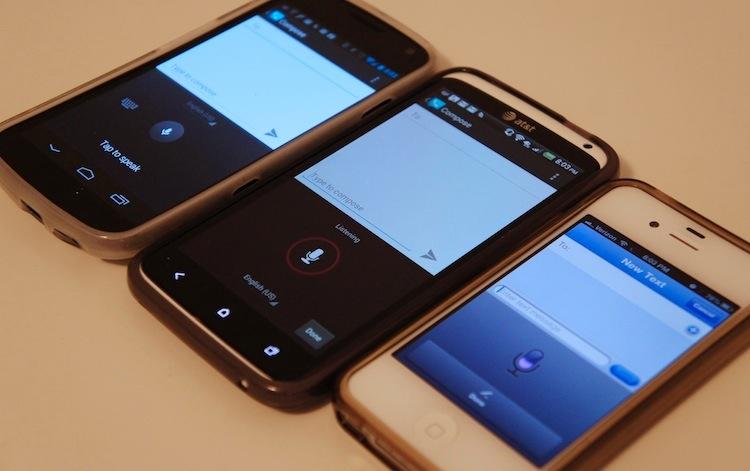
I'm on day four of the Voice Input Challenge, but it has felt like an eternity since I woke up on Monday morning and realized it would be another seven days before I could grace my thumbs with the predictive power of SwiftKey to text message, Google search and tweet.
As I explained on Tuesday, the whole challenge was a bit rocky from the beginning. Going into it, I knew it would be. But there were some unforeseen issues that I ran into immediately that inhibited me from using my phones as I normally would. Proper nouns and punctuation have proven to be just as tricky now as they were then, and I'm still struggling to find a way around using uncommon words. And I can't even tweet the way I normally would because the dictation software wasn't built with ambiguous Twitter usernames in mind.
But, in truth, I've learned a lot and the past four days haven't been as bad as it may sound. So here's a quick update to cover some of my latest findings:
So there's yet another problem that slipped under the radar when I was ironing out the kinks of this particular challenge: passwords and PINs. If you have your phone password or pin locked, dictation is neither possible or a great idea. And this is one of the few reasons dictation could never fully replace soft keyboards.
For starters, the dictation button is disabled for password entry. Not only that, I'm not sure why anyone would want to verbally input their password, as it would give any eavesdroppers access to your account(s). And if your password is easily pronounced, you may want to consider beefing up your security anyway.
But there is a way around having to type passwords, which is how I've been making it through this challenge. I use LastPass to keep a vault of all my passwords for all of my accounts. To login to an account, I just copy and paste the usernames and passwords from LastPass to login to any accounts. It's a bit cumbersome, but luckily I will only have to resort to this for the next three days.
This may seem pretty obvious. I've used dictation hundreds of times for various reasons in the past. But I just did it because I only had one free hand, physically typing a message would take too long or just because I wanted to test dictation out after a software update. I never hit the dictation button because I wanted to or preferred it over typing out a message.
Of course, after a couple days of forcing myself to use dictation, it has become a bit more natural to use. But I have also discovered some of its strengths. It's particularly great at quick replies to text messages. Where typing something on an on-screen keyboard might take upwards of a minute to type, dictation may only take a few seconds.
One of the biggest hurdles when starting this challenge was using dictation around people or in public. It still doesn't feel quite as comfortable to use as standard keyboard input in close public quarters. But using it around my friends or in a public area with a little more room and background noise is no problem.
At first, using dictation in public was just as awkward as wearing a Bluetooth headset and talking on it in public. In contrast, though, Bluetooth headsets never became any easier or less awkward to use around people. Asking a quick question of Google voice search or Siri isn't so bad anymore.
I still get some odd looks from friends and strangers alike, but I'm also getting used to it an learning to blow off the gawking people.
My goal in this challenge wasn't exactly to compare the dictation software in iOS and Android. It was mainly to see how well-rounded the software is, if it can be used full-time and to find any remaining shortcomings of mobile voice input. That said, a comparison of the two was inevitable and I plan to provide a more in-depth comparison of the strengths and weaknesses of each in my final update next week.
To be as concise as possible, between the two, I prefer Android voice typing over the iOS dictation. The reason is simple: text displays as you speak. With Android dictation, words will display almost immediately after you speak them. And if it misinterprets your speech, a "Delete" button appears after the last word and will delete the last bit you spoke. It's lacking some voice controls, such as being able to input a new line, capitalizing proper nouns and the majority of punctuation. But it seems to be more accurate and the real time text entry makes speaking to the device feel a bit more natural – the instant gratification really helps.
On iOS, while you have a plethora of options when it comes to entering punctuation and capitalizing words verbally, text doesn't display until after you hit the "Done" button. This makes it impossible to see in real time if you have made an error. And if you're speaking a long sentence or an entire paragraph, it's easy to forget what you have already said. If it completely botches transcribing what you spoke, you have to select delete each and every letter individually or select all and delete.
I am glad to say this challenge is going more smoothly than I would have expected. But that doesn't mean it isn't difficult. I can't express how bad I just want to go back to using SwiftKey and typing out websites and email addresses. But, aside from a few minor complications, I'm surprised at how well dictation has worked thus far.
There are only three full days left in the challenge and I really plan to put dictation through its paces over the weekend. Stay tuned for the final update on Monday ...